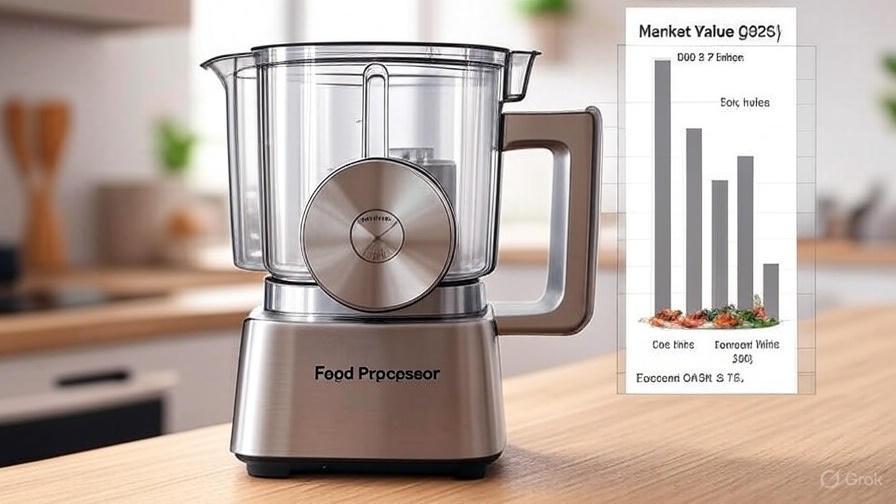Food Processor Market to Hit USD 3.7 Billion by 2035

The global food processor market is on a growth trajectory, with its value expected to rise from USD 2.1 billion in 2025 to USD 3.7 billion by 2035, at a CAGR of 5.7%. Driven by shifting consumer lifestyles, the popularity of home cooking, and growing demand for multifunctional kitchen appliances, the market is becoming a key segment within the broader home and professional kitchen appliance sector. Both established players and emerging manufacturers are racing to deliver solutions that balance convenience, innovation, and durability.
Changing Consumer Preferences
From 2025 to 2030, steady growth will be driven by consumers upgrading older models and embracing compact food processors suited to smaller households. By 2030 to 2035, momentum will accelerate as demand shifts toward advanced appliances offering chopping, blending, kneading, and even food preservation features, many integrated with smart connectivity. This consumer shift highlights how urban lifestyles and health-focused diets are reshaping the expectations for kitchen appliances.
Full Market Report available for delivery. For purchase or customization, please request here: https://www.futuremarketinsights.com/reports/sample/rep-gb-25038
Technology and Design Innovation
Manufacturers are investing in ergonomic designs, energy-efficient motors, and easy-to-clean components, catering to time-conscious households. Established leaders such as Philips, Bosch, and KitchenAid are pioneering premium models with robust performance, while brands like Ninja and Moulinex focus on affordability and compact innovation. Startups are also entering the space with smart-enabled devices, collaborating with recipe app developers and accessory suppliers to deliver personalized cooking experiences.
Retail Transformation and Market Access
The expansion of online retail channels, direct-to-consumer sales, and bundled promotions has improved accessibility for consumers across regions. E-commerce platforms provide visibility and price competitiveness, while organized retail stores give buyers the opportunity to test functionality. In emerging markets such as China and India, rising disposable incomes and exposure to modern cooking practices are fueling adoption, with growth rates projected at 7.7% and 7.1% respectively.
Market Dynamics and Growth Drivers
The market draws influence from five interconnected segments. The home kitchen appliance sector contributes the largest share at 40%, as families seek multipurpose units to simplify meal preparation. Compact appliances for small households represent 25% of demand, while commercial kitchens contribute 15% as restaurants and caterers rely on heavy-duty machines. E-commerce accounts for 12%, and the aftermarket repair and spare parts sector supports 8%, ensuring product longevity. Collectively, these segments reflect how both residential and professional kitchens fuel demand.
Segmental Insights
Among product types, full-sized food processors dominate with 46.8% of revenue in 2025. Their large capacity, interchangeable attachments, and durability make them popular among families and small food businesses. Electric food processors lead the mode of operation category, capturing 71.4% share due to their efficiency and consistency. In terms of capacity, the 2–5 liters range commands 53.6% share, balancing performance and space efficiency for households.
Regional Perspectives
China leads global growth with a projected CAGR of 7.7% between 2025 and 2035, supported by urban household adoption and a rising middle class. India follows closely at 7.1%, driven by changing cooking habits and compact living needs. In Europe, France and Germany are seeing growth in premium, energy-efficient models, while the UK market is responding to plant-based diets and compact urban living. In the United States, multifunctional appliances with smart integration are shaping consumer choices, supported by strong retail networks and influencer-driven marketing.
Trends in Consumer Behavior
The rise of health-conscious meal preparation is significantly boosting market demand. Households are increasingly drawn to appliances that facilitate homemade smoothies, purees, and vegetable-based meals. This trend is particularly strong among millennials and fitness-conscious families, fueling innovation in BPA-free designs, dishwasher-safe parts, and noise-reduction technology. Similarly, commercial kitchens and catering businesses continue to demand durable, large-capacity machines to handle high-volume preparation, strengthening the market’s professional segment.
Competitive Landscape
Competition in the food processor market centers on multifunctionality, durability, and user experience. Philips continues to lead with versatile and efficient models, while Bosch, Black+Decker, and Braun emphasize compact, ergonomic designs. Premium brands such as Breville, Cuisinart, and KitchenAid dominate the high-performance segment, appealing to culinary enthusiasts. Regional and mid-tier players, including Electrolux, Hamilton Beach, Kenwood, Magimix, Moulinex, Ninja, Oster, and Panasonic, expand accessibility by offering affordable, specialized solutions.
Manufacturers are leveraging collaborations with culinary schools, influencer campaigns, and recipe platforms to strengthen consumer engagement. Innovations such as modular attachments, intuitive controls, and energy-efficient motors highlight the market’s focus on user-centric design.
- Art
- Causes
- Crafts
- Dance
- Drinks
- Film
- Fitness
- Food
- Games
- Gardening
- Health
- Home
- Literature
- Music
- Networking
- Other
- Party
- Religion
- Shopping
- Sports
- Theater
- Wellness


